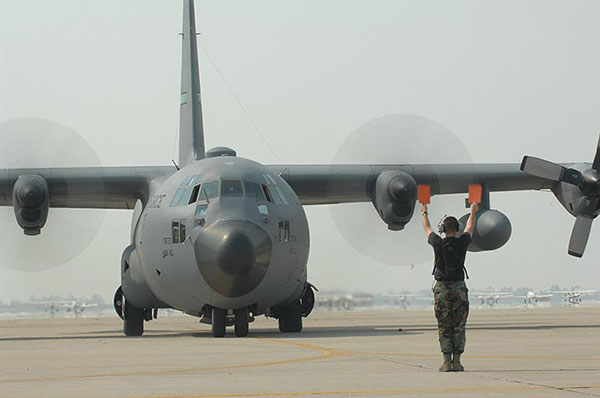New lab will have wings

Researchers from the Air Force and UDRI will advance technology in a C130 at UDRI headquarters
By Air Force Product Support Engineering Division
Officials from the Air Force Life Cycle Management Center and the University of Dayton Research Institute will accept delivery of a C-130 aircraft from Eglin Air Force Base, Fla., at UDRI’s headquarters building today.
The aircraft, which has been decommissioned, will be used to demonstrate and test a number of technologies designed to lower the cost of sustaining the Air Force’s C-130 fleet.
Work will be performed in and on the aircraft as well as in other UDRI support labs.
With a wing span of 133 feet, the aircraft was partly disassembled at Eglin AFB for the trip to UDRI.
This video shows the C-130 Hercules fuselage entering UDRI's River Campus at Daniel J. Curran Place.
A 2,500-square-foot concrete pad has been poured to support the aircraft, which weighs approximately 40 tons when empty.
Once reassembled, researchers from UDRI will perform the work in collaboration with AFLCMC’s Product Support Engineering Division and the AFLCMC C-130 Program Office.
“The Air Force spends a lot of money on aircraft sustainment,” said Debbie Naguy, AFLCMC Product Support Engineering Division chief. “The C-130 that is being delivered here today will help us demonstrate and qualify new innovative technologies to lower sustainment costs and improve readiness.”
Brian Stitt, division head for Sustainment Technologies Transition at UDRI, said technology development and demonstration under the program will include micro-vanes for fuel savings, additive manufacturing, cold spray for repairs, robotics and lasers for paint removal, environmental evaluation of coatings, augmented and virtual reality, condition-based maintenance, and aircraft battle damage repair.
Although several of these technologies are emerging, they are already proving valuable in the sustainment of legacy aircraft. For example, advances in additive manufacturing—also known as 3-D printing—are enabling the Air Force to produce, on demand, small quantities of aircraft parts that are no longer being manufactured, and at a fraction of the cost of retooling to reproduce the part.
“The challenge is that, in many cases, no technical information exists on these parts because of the age of the aircraft,” Naguy said. “So when a replacement part or structure is needed and there is no drawing available, we will reverse engineer the part, scanning it to create a three-dimensional digital model that be used to develop and qualify AM replacement parts.”
In the process, the team will create a “digital thread,” an electronic database documenting all information on the part and process used to create it.
The faster these technologies are developed and advanced, the bigger the impact will be for use across the Air Force enterprise, Stitt said. And having an aircraft on site, with unlimited access, allows expedited execution.
The program is expected to last between 18 and 24 months and involve students from the University of Dayton, Ohio State University and Wright State University working alongside Air Force and UDRI engineers and researchers to advance these game changing technologies.
For additional information, contact Pamela Gregg, Communication Administrator, UDRI at 937-229-3268.
May 15, 2019
